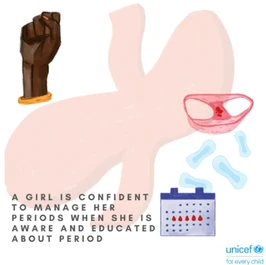
MENSTRUATION-
CHALLENGES AND WAY FORWARD
UNICEF
MENSTRUATION-
CHALLENGES AND WAY FORWARD
Documentation of the Menstrual Hygiene and Health Programs in 6 States and Inform the Model to Institutionalise MHM at a State Level
Client: UNICEF
Scope of Work: Research, Documentation, Assessment and Creative Content Production


ASSESSMENT OF
MHM PROGRAMING
AT STATE LEVEL- 6 STATES
Menstrual Hygiene Management is a small part of several government run programs. This has often kept MHM from being prioritised.
The purpose of this assignment was to conduct a large scale study in 6 states to investigate the need and ways to integrate and institutionalise MHM programming at state levels.
In the first phase of the project, Kaboom was to study where the MHM programming sits within the existing government structures in India and highlight the good practices that can be replicated.
The second phase was to provide inputs for mainstreaming MHM programming and inform the development of a model for implementation in the 6 states in India.
PHASE 1
ASSESSMENT, EVIDENCE COLLECTION
Kaboom created the first of its kind, a robust document on state levels implementation of Menstrual Hygiene Management in 6 states of India.
This comprehensive evidence carried successes, challenges, roadblocks and barriers highlighting innovations within each state. Clear links were established between existing programs with possible indicators to examine MHM.
Finally, the report provides a roadmap for mainstreaming MHM programing at state level providing a possible model of implementation to fit each state. The document is rich with infographics and photographs that capture the learnings and ensure an uptake at state levels.


PHASE 2
RECOMMENDATIONS TO INSTITUTIONALISE MENSTRUAL HEALTH AT STATE LEVEL
Kaboom created the first of its kind robust document on state level implementation of Menstrual Hygiene Management in 6 states of India.
This comprehensive evidence carried successes, challenges, roadblocks and barriers highlighting innovations within each state. Clear links were established between existing programs with possible indicators to examine MHM.
Finally, the report provides a roadmap for mainstreaming MHM programing at state level providing a possible model of implementation to fit each state. The document is available in the form a well-designed with rich with infographics and photographs to ensure an uptake at state levels.
REPORTS

THE FILMS
CAMPAIGN COLLATERALS









